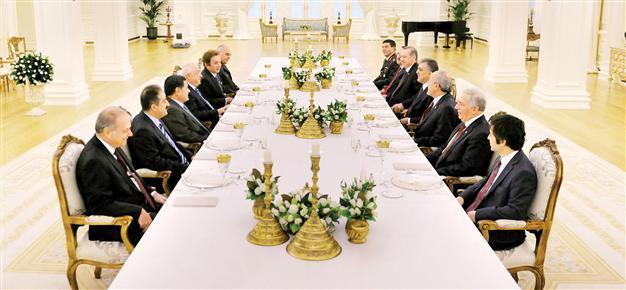No woman, no try
MURAT YETKİN

The all-male heads of Turkey’s legislative, judicial and executive branches enjoy a luncheon hosted by President Abdullah Gül (4-R) in Ankara amid a fiery debate over the separation of powers. Courtesy of the Presidents Office
It was good of Turkish President Abdullah Gül to convene heads of the executive, legislative and judicial powers over a new years’ lunch in the Çankaya Presidential Palace in Ankara on Jan. 2. He had done that before but this year it had additional meaning since Prime Minister Tayyip Erdoğan has begun a debate on the relevance of separation of powers.
It is good that President Gül is highlighting the separation and diversity in the Turkish administration.
What is not good is the lack of gender diversity in the Turkish administration.
There are holders of 13 important seats in the picture on both sides of the presidential table, including Prime Minister Erdoğan, Parliamentary Speaker Cemil Çiçek and Head of Constitutional Court Haşim Kılıç. Unfortunately this is a picture where there is not even one seat left for women at decision-making levels in the Turkish system at the beginning of 2013. Half of the population has not even one voice over a lunch of 13.
But was there any time when there were women at this level? The answer is, yes. There were not enough of those times, too, but yes, there has been a female prime minister, head of constitutional court and similar higher posts before. Not anymore.
The situation is getting worse regarding the visibility of women in the Turkish administrative system. According to a report by the Directorate of the Status of Women under Family and Social Policies Minister Fatma Şahin, the only female minister in the cabinet, female participation in the workforce has dropped from 34 to 26 percent in the 20 years between 1990 and 2010. The tendency shows that it will further drop according to figures in the same ‘State of Women’ reports from 2010 and 2011.
For example, there is not a single female undersecretary for any ministry (not even for Şahin). There is only one female governor out of 81 provincial governors in Turkey. Out of 464 deputy provincial governors, only 10 are women. Out of 891 junior or county governors only 13, and worse, out of 261 governor candidates in job training only eight are women. The Foreign Ministry is the best – if it is correct to say best – among the bureaucracy: 11 out of 110 ambassadors are women. Overall, only 7 percent of Turkish bureaucrats are women.
In universities, one out of four professors is female. But for some 700 thousand illiterate men in Turkey’s 70 million-strong population, there are more than 3 million illiterate women.
In the private sector the situation gets tragic. Two out of three women are denied social security rights. In the agricultural sector, 77 percent of women are given no money at all for the heavy work; it’s called “family business.” Turkey’s top industrialists association TÜSİAD’s chairwoman Ümit Boyner is leaving her chair to a male colleague, Muharrem Yılmaz, with complaints of hidden discrimination especially from politicians.
Prime Minister Erdoğan attended an international meeting on family and social policies hosted by Minister Şahin. He repeated his, “at least three children” demand (adopted, by the way, by Russian President Vladimir Putin as well), which might tie more women to their homes. But the number one problem for women in today’s Turkey is violence against women. The Turkish TV regulatory board RTÜK fined a popular TV station a record-breaking amount because it showed the beating of women as something funny in a comedy show; it is a social problem.
Is it a coincidence that violence against women becomes a bigger social problem as visibility of women in universities, businesses, bureaucracy and politics declines?
Turkey was already a man’s world but it gets denser. Addressing an annual national diplomatic convention, Turkish Foreign Minister Ahmet Davutoğlu gave figures on how Turkey is getting ready to fly higher.
The photo in Çankaya is simply an effort to try to fly high when one of the wings is broken or bandaged and hung around your neck.
